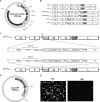Neuroattenuation of vesicular stomatitis virus through picornaviral internal ribosome entry sites
- PMID: 23283963
- PMCID: PMC3592162
- DOI: 10.1128/JVI.02984-12
Neuroattenuation of vesicular stomatitis virus through picornaviral internal ribosome entry sites
Abstract
Vesicular stomatitis virus (VSV) is potent and a highly promising agent for the treatment of cancer. However, translation of VSV oncolytic virotherapy into the clinic is being hindered by its inherent neurotoxicity. It has been demonstrated that selected picornaviral internal ribosome entry site (IRES) elements possess restricted activity in neuronal tissues. We therefore sought to determine whether the picornavirus IRES could be engineered into VSV to attenuate its neuropathogenicity. We have used IRES elements from human rhinovirus type 2 (HRV2) and foot-and-mouth disease virus (FMDV) to control the translation of the matrix gene (M), which plays a major role in VSV virulence. In vitro studies revealed slowed growth kinetics of IRES-controlled VSVs in most of the cell lines tested. However, in vivo studies explicitly demonstrated that IRES elements of HRV2 and FMDV severely attenuated the neurovirulence of VSV without perturbing its oncolytic potency.
Figures









Similar articles
-
Vesicular stomatitis virus expressing tumor suppressor p53 is a highly attenuated, potent oncolytic agent.J Virol. 2011 Oct;85(20):10440-50. doi: 10.1128/JVI.05408-11. Epub 2011 Aug 3. J Virol. 2011. PMID: 21813611 Free PMC article.
-
A Temperature-Dependent Translation Defect Caused by Internal Ribosome Entry Site Mutation Attenuates Foot-and-Mouth Disease Virus: Implications for Rational Vaccine Design.J Virol. 2020 Jul 30;94(16):e00990-20. doi: 10.1128/JVI.00990-20. Print 2020 Jul 30. J Virol. 2020. PMID: 32493820 Free PMC article.
-
Lassa-vesicular stomatitis chimeric virus safely destroys brain tumors.J Virol. 2015 Jul;89(13):6711-24. doi: 10.1128/JVI.00709-15. Epub 2015 Apr 15. J Virol. 2015. PMID: 25878115 Free PMC article.
-
Vesicular stomatitis virus as a flexible platform for oncolytic virotherapy against cancer.J Gen Virol. 2012 Dec;93(Pt 12):2529-2545. doi: 10.1099/vir.0.046672-0. Epub 2012 Oct 10. J Gen Virol. 2012. PMID: 23052398 Free PMC article. Review.
-
Vesicular stomatitis virus: re-inventing the bullet.Trends Mol Med. 2004 May;10(5):210-6. doi: 10.1016/j.molmed.2004.03.003. Trends Mol Med. 2004. PMID: 15121047 Review.
Cited by
-
Recent advances in vesicular stomatitis virus-based oncolytic virotherapy: a 5-year update.J Gen Virol. 2017 Dec;98(12):2895-2911. doi: 10.1099/jgv.0.000980. J Gen Virol. 2017. PMID: 29143726 Free PMC article.
-
Ovarian cancer treatment with a tumor-targeting and gene expression-controllable lipoplex.Sci Rep. 2016 Mar 30;6:23764. doi: 10.1038/srep23764. Sci Rep. 2016. PMID: 27026065 Free PMC article.
-
IMMUNO-COV v2.0: Development and Validation of a High-Throughput Clinical Assay for Measuring SARS-CoV-2-Neutralizing Antibody Titers.mSphere. 2021 Jun 30;6(3):e0017021. doi: 10.1128/mSphere.00170-21. Epub 2021 Jun 2. mSphere. 2021. PMID: 34077262 Free PMC article.
-
Oncotargeting by Vesicular Stomatitis Virus (VSV): Advances in Cancer Therapy.Viruses. 2018 Feb 23;10(2):90. doi: 10.3390/v10020090. Viruses. 2018. PMID: 29473868 Free PMC article. Review.
-
Characteristics of oncolytic vesicular stomatitis virus displaying tumor-targeting ligands.J Virol. 2013 Dec;87(24):13543-55. doi: 10.1128/JVI.02240-13. Epub 2013 Oct 2. J Virol. 2013. PMID: 24089573 Free PMC article.
References
-
- Alajez NM, Mocanu JD, Shi W, Chia MC, Breitbach CJ, Hui AB, Knowles S, Bell JC, Busson P, Takada K, Lo KW, O'Sullivan B, Gullane P, Liu FF. 2008. Efficacy of systemically administered mutant vesicular stomatitis virus (VSVDelta51) combined with radiation for nasopharyngeal carcinoma. Clin. Cancer Res. 14:4891–4897 - PubMed
-
- Shinozaki K, Ebert O, Woo SL. 2005. Treatment of multi-focal colorectal carcinoma metastatic to the liver of immune-competent and syngeneic rats by hepatic artery infusion of oncolytic vesicular stomatitis virus. Int. J. Cancer 114:659–664 - PubMed
-
- Stojdl DF, Lichty B, Knowles S, Marius R, Atkins H, Sonenberg N, Bell JC. 2000. Exploiting tumor-specific defects in the interferon pathway with a previously unknown oncolytic virus. Nat. Med. 6:821–825 - PubMed
MeSH terms
Substances
LinkOut - more resources
Full Text Sources
Other Literature Sources

